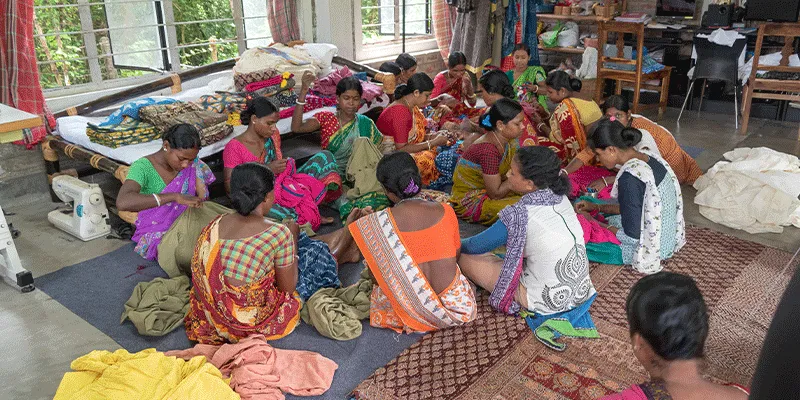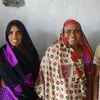How better eyes with tech can give NRLM more legs
A technology-driven tracking mechanism is the key to truly deliver and measure the outcomes of enhanced livelihood for every household under the NRLM.
In the 10 years of National Rural Livelihood Mission’s (NRLM) existence, it has mobilised over 8 crore women into 73 lakh Self-Help Groups (SHGs) in 30 states and 6 Union Territories, involving a cumulative central allocation in excess of Rs 100,000 crore.
Predictably, more than Rs 13,000 crore has been allocated to NRLM for financial year 2022-23. On the face of it, the numbers are staggering. But these figures don’t fully inform us about the real impact of NRLM. The programme has to take a paradigm shift from universal access to quality of the access. This is similar to the National Multidimensional Poverty Index by Niti Aayog, which focuses on utilisation and goes beyond the magnitude and numbers.

Members of an SHG in West Bengal create handicrafts to earn a livelihood.
The social impact of NRLM has been widely visible, with SHGs having a strong impact on women’s empowerment, including political participation, awareness about the local administration, financial literacy, mobility, and decision-making. It has also enabled rural families to negotiate for greater access to education and healthcare.
While the social impact has been evidenced in various research studies conducted across some state rural livelihood missions, large scale economic impact is yet to be determined.
In 2020, researchers from 3ie examined the impact of NRLM in nine of India’s poorest states. They found that while 48 percent of SHG loans were used for consumption purposes, only 19 percent were used for productive purposes like supplementing their livelihood. And, only 65 groups across the nine states that were studied had initiated some form of entrepreneurial activities. Clearly, there is a dire need for India level data.
A key success factor for NRLM is effective “fund rotation”, which helps increase inclusion and access to funds. However, NRLM data doesn’t answer many critical questions about its efficacy. If available, they could plug systemic gaps. Some of these questions are:
- Who are these women with access to NRLM funds?
- Have funds reached the right population segment?
- Has it been used productively? If so, has it happened over multiple time cycles?
- Is the fund repayment happening?
- Are subsequent fund rotation reaching the target audience to increase inclusion?
- How many of the SHGs created have become defunct and why?
- What has been the real economic impact of the NRLM funds?
Recounting a recent incident from the field, a community leader, also the president of a cluster level federation, had misdirected Rs 5 lakh into her personal bank account. With all physical registers containing details of the 10 SHGs that the fund was meant for, there was no way to hold her accountable.
The only way to track these kinds of misappropriation is to track last mile delivery. Till we lack convergence with digital financial systems, there will be numerous repeat offences like these. While the mission’s focus has been primarily on coverage, funds released translates to measurement in terms of increasing the quantum of end beneficiaries, our experience tells us otherwise.
NRLM’s next step
Going beyond income levels, NRLM prioritises livelihoods as a primary pathway to associated social outcomes like improved indicators for health, nutrition, education and women’s empowerment. Embedded in a community owned model, the entire funding system of NRLM hinges on credit linkages and rotation of funds for long term accessibility and sustainability.
The focus of the government so far has been on accessibility and inclusion. It must now move on to address issues related to sustainability.
This would require identifying systemic gaps, which in turn would mean tracking the program at a more granular level. What could be the features of such a tracking system? Here are some suggestions.
Towards a monitoring mechanism
Measuring effectiveness of the programme would first require mapping the pathway to the last mile beneficiary. At present, data availability for fund disbursement is limited to institutions–the SHGs. The programme needs monitoring mechanisms at various levels and for multiple stakeholders. For State Rural Livelihood Missions (SRLM), it will mean tracking the fund till the end beneficiary, their repayment patterns and further rotation. For the district and block level administration, it will ensure transparency.
The biggest risk currently is the use of cash transactions. The moment cash comes into the system, we lose control over the tracking mechanism. And for the community institutions, this monitoring will ensure equitable access to funds.
Social inequality is a natural barrier to equitable access to funds. Therefore, data driven governance will help ensure transparency and aid in better programme monitoring, which in turn will help determine whether the fund is achieving its target of bringing value to additional women under its fold.
The good news is that today, the country has the ability to map SRLM impact at the member level. We have witnessed the impact of linking the JAM (Jan Dhan-Aadhaar-Mobile) trinity, towards effective disbursement of Direct Benefit Transfers (DBTs). The SRLMs have an additional layer of community decision making towards last mile disbursement to individual members. And, for this, the government needs transparency on fund disbursement and utilisation, which it can then map to the changes in livelihood pattern.
Technology can be the single biggest leverage to not only link fund flow from the government systems to SHGs, but also a way to link SHG bank accounts to individual bank accounts (in turn linked to their Aadhar numbers) of the members.
Fintechs and MFIs have solved this aspect for rural setups. Quite a few of them have developed transparent mechanisms to track and measure utilisation till the last mile beneficiary as well. If this can be replicated within NRLM, it will not only bring all fund recipients under the government's monitoring mechanism, but also shed light on their consumption and livelihood patterns.
Of course, on measuring the impact in terms of livelihood enhancement, we have to realise that livelihoods for different layers of the poor are not identical. There is a need to target them correctly, map their vulnerabilities and social realities, and then include them into policymaking. This is where the tracking mechanism will be most useful doing away with tedious surveys and associated errors and inconsistencies. This can be backed with vernacular localised support. On a probability+possibility index, the government has the necessary resources and civil society organisations can adapt, implement and embed it within government systems.
A technology-driven tracking mechanism is the key to truly deliver and measure the outcomes of enhanced livelihood for every household under the NRLM fold.
Edited by Megha Reddy
(Disclaimer: The views and opinions expressed in this article are those of the author and do not necessarily reflect the views of YourStory.)







